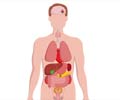Newly detected gene mutations and some cases of the progressive fatal neurological disease amyotrophic lateral sclerosis (ALS), also known as Lou Gehrig's disease linked by researchers.

Scientists at the University of Massachusetts Medical School, Worcester, collaborated with international ALS researchers to search for gene mutations in two large families with an inherited form of ALS. The researchers used a technique to decode only the protein-encoding portions of DNA, known as the exome, allowing an efficient yet thorough search of the DNA regions most likely to contain disease-causing mutations. This deep sequencing of the exome led to the identification of several different mutations in the gene for profilin (PFN1) which were present only in the family members that developed ALS. Further investigations of 272 other familial ALS cases across the world showed that profilin mutations were also found in a small subset (about 1 to 2 percent) of the familial ALS cases studied.
The protein profilin is a key part of the creation and remodeling of a nerve cell's scaffolding or cytoskeleton. In fly models, disrupting profilin stunts the growth of axons – the long cell projections used to relay signals from one neuron to the next or from motor neurons to muscle cells. After identifying the PFN1 mutations in ALS patients, the researchers demonstrated that these mutations inhibited axon growth in laboratory-grown motor neurons as well. They also found that mutant profilin accumulated in clumps in neural cells, as has been seen for other abnormal proteins associated with ALS, Parkinson's and Alzheimer's. Neural cells with PFN1 mutations also contained clumps of a protein known as TDP-43. Clumps of abnormal TDP-43 are found in most cases of ALS, further linking profilin to known ALS mechanisms.
John Landers, Ph.D., associate professor of neurology at the University of Massachusetts Medical School, described how studying ALS in large families is challenging. "ALS is a late-onset, rapidly progressive disease. Unless you've been following a family for decades, it is hard to get DNA samples to study," Dr. Landers said. "We were very fortunate to obtain the DNA samples with the help of our research collaborators and the affected families."
Over a dozen genes have been linked to ALS, and these findings support existing studies which suggest that cell cytoskeleton disruptions play a major role in ALS and other motor neuron diseases. Motor neurons are large cells with long axons that connect to muscle, and cytoskeleton proteins are especially important in the transport of proteins along the axon to the remote parts of the neuron. This information could be useful in developing strategies for detection and treatment of ALS.
"In all of the causative genes that we identify, we look for common pathways," Dr. Landers said. "Every time we are able to identify a new gene, we have another piece of the puzzle. Each one of these genes helps us to understand what's going on. The more of these we can find, the more we're going to know about what's going wrong in ALS."
Advertisement
"This discovery is highly significant and opens a new avenue of research," commented Amelie Gubitz, Ph.D., program director at the National Institute of Neurological Disorders and Stroke (NINDS), which funded the research. "There is growing evidence that ALS may be caused by a variety of cellular defects, and that it is a not a disorder with a single origin. Whether and where these disease pathways converge is an active area of research with important implications for therapy development."
Advertisement















